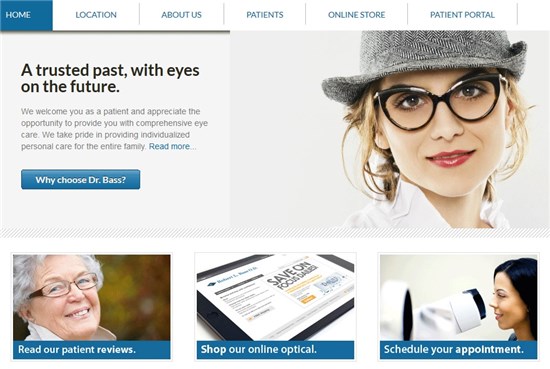By Robert L. Bass, OD, FAAO
August 5, 2015
SYNOPSIS
Set a practice growth strategy based on effective recall. Test and track various patient communications approaches, with help from automated systems.
ACTION POINTS
PROVIDE INCENTIVE. Offer discounts on second pairs, sunwear, or other items, to induce patients to return.
CREATE SYSTEM. Keep letters on file that can be personalized when needed, let patients know when you would like to see them again and have staff also mention it.
MEASURE SUCCESS. Use systems like Demandforce and your practice management system to track how many patients communicated with return.
Patient recall should be the cornerstone of any strategy to increase the number of patients you see. At my practice, we take recall very seriously, and have implemented an organized system to ensure our patients are alerted about upcoming appointments–and actually show up again in our office.
Craft a Recall Letter (Sample)
There are many ways to craft your practice’s recall letter to patients. This is a sample of a typical recall letter from my practice:
“Dear Mr. Smith,
During your last examination here in our office, I suggested you return for a routine re-evaluation in one year. In addition to examining, diagnosing, treating and managing diseases and disorders of the visual system, eye and associated structures, we work closely with your family doctor to manage systemic conditions like diabetes and hypertension.
We also co-manage cataract and refractive laser surgeries to ensure better continuity of care. By utilizing our specialized instruments, we are able to provide the most comprehensive eyecare possible for you and your family.
If you have scheduled your visit prior to receiving this correspondence, I look forward to seeing you soon. If not, please contact the office to schedule this re-evaluation. It’s an important part of your overall care plan.”–Robert Bass, OD
Give Incentive to Return
We have13,438 patients in our patient database, and currently see 2,650 patients annually, mailing each a letter by postal mail that includes a promotional offer, such as a discount on a second-pair purchase, or maybe a discount on sunwear, to induce them to return for their next needed appointment. Average time to revisit with insurance is 11-14 months; without insurance, it’s 12-30 months.
Make Recall a Systematic Process
The recall process is part of what we do every day; a patient comes in, has an exam, purchases products, pays and is scheduled in our practice management software (PM) for a recall. Recall dates vary from annual wellness-check eye exams to monthly/quarterly medical eye exams. My staff makes time, or in their down time, prints out patient-specific letters from our PM twice a month and stuffs envelopes with the letter and timely office promotions.
We also employ Demandforce, which integrates with our PM and extracts patients’ recall dates, e-mail addresses and cell phone numbers. Demandforce, after getting the patient’s approval for mode of communication, may recall them by e-mail and or/ text message. We have found real (snail) mail, plus e-mail, is the most effective way to get patients to return to our office. We found a 23 percent decrease in patients returning with e-mail only.
Staff time required : real mail two times a month; printing, stuffing, postage and post-office: 2.5 hours twice a month. Staff time and materials cost about $300, or about one patient to return by recall.
Gauge Success of Recall Efforts
To quantify your level of success, you can see in “reports” of your PM how many you recalled and how many returned within 30-60 days of recall. Also, Demadforce prides itself on giving you that number and how much money ”they made you” by Demandforce recall. But I cannot differentiate if my letter or Demandforce’s e-mail recall pushed the patient to return. I call tell you, as noted, that when experimented with electronic only, my recall return rate dropped by 23 percent, and that when we only send an e-mail, 30 percent do not come back in 12-14 months.
One letter and two e-mails sent by Demandforce has proven to be the best strategy for us. At 18 months, we gain 12 percent returning, after a second letter is sent, along with 4-6 additional e-mails. That 12 percent will be recalled again at two years. In terms of insurance demographics: above 2,650 past 12 months=1,643 VSP Vision Insurance, 48 Private Pay, 959 Medical Insurance. So, if 80 percent of my practice is not paying full fees, then you can expect them to return more often. The patients with insurance coverage come annually as “instructed”; whereas patients without insurance may return as instructed, but usually do not. Again, then we employ multiple recall methods.
Dr. Bass’s practice web site’s homepage features a place to click to easily schedule an appointment, making recall faster and easier.
Doctor Should Tell Patient of Need to Return
My practice has always had a doctor protocol to tell the patient when we want to see them again and the doctor verbally repeats it in front of the patient to the front desk or the technician who is escorting the patient from me. And, yes, I have the needed return date logged into the EHR!
Related ROB Articles
Five Ways to Ensure Patients Return
A Patient Recall Strategy That Works
Online Appointment Booking: New Patients Love It
Robert L. Bass, OD, FAAO, is the owner of Optometric Associates, PC, in Manassas, Va. To contact: idr.bass@verizon.net




























